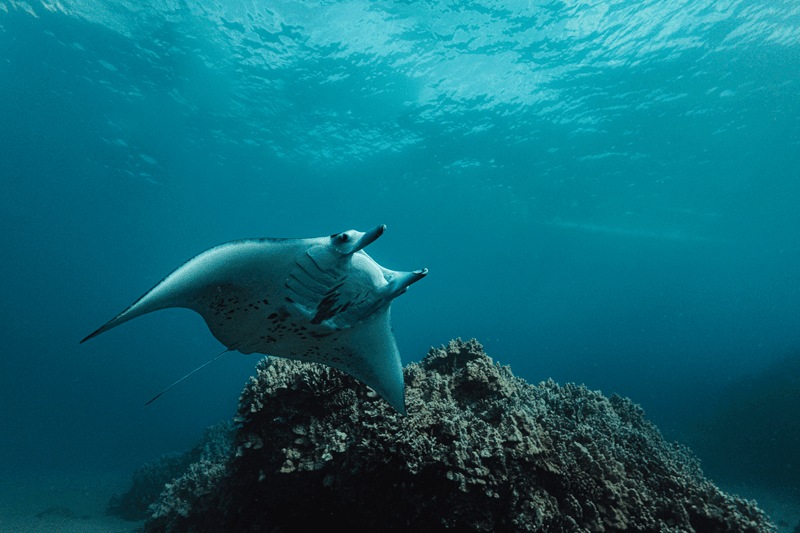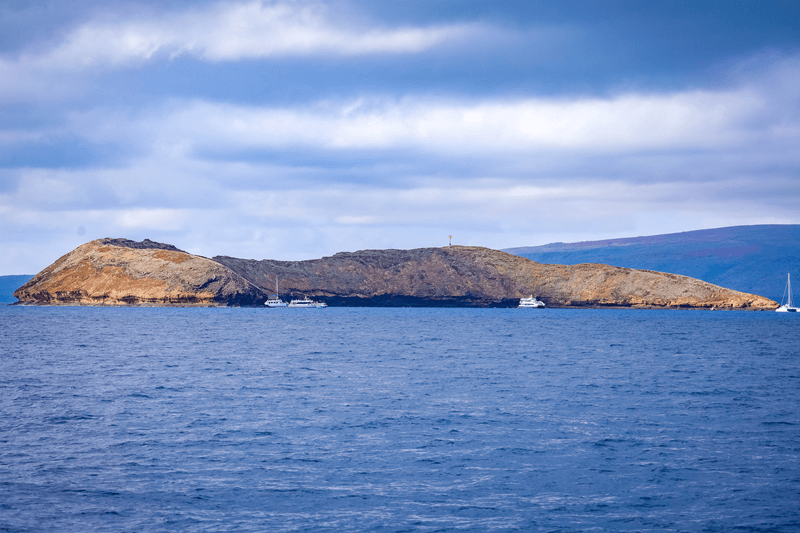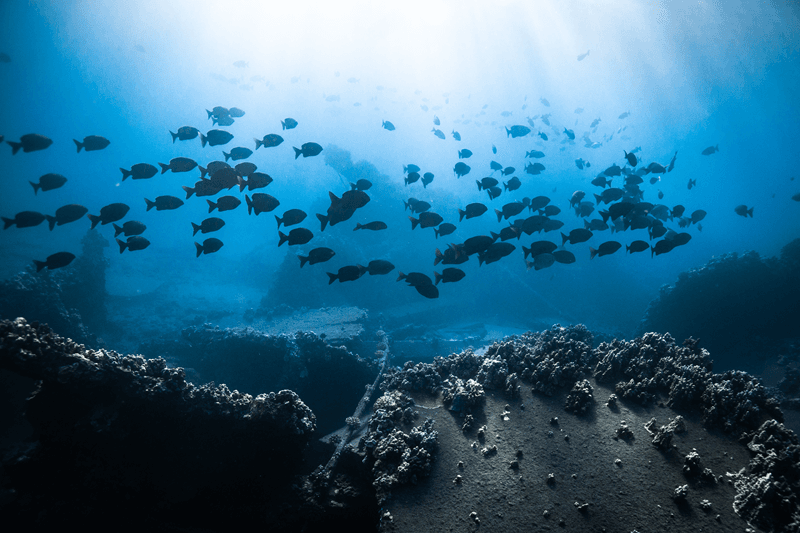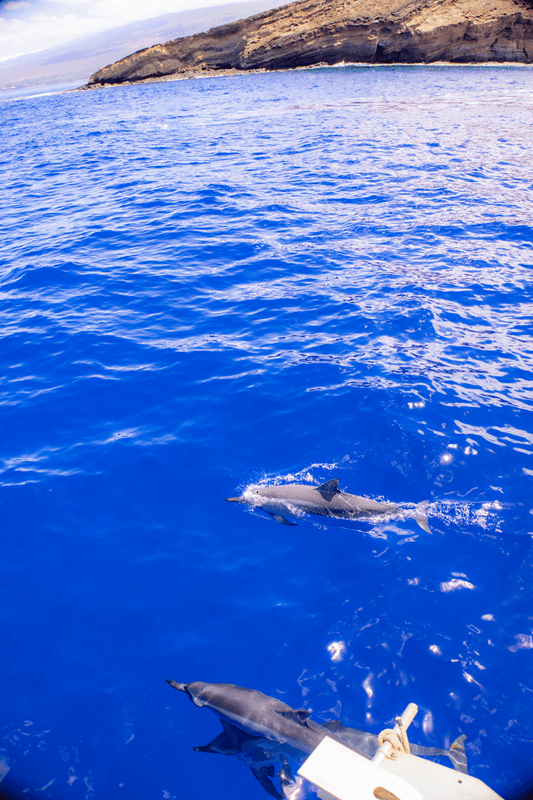Molokini marine life showcases Hawaii’s most vibrant underwater world—crystal-clear snorkeling with butterflyfish, tangs, and Moorish idols inside a protected crater—while Turtle Town brings close encounters with green sea turtles along stunning lava-finger reefs.
Planning a snorkel at Molokini Crater or Turtle Town? Here’s a quick, experience-based guide to the Molokini marine life you’re likely to see (and how often), the best time to go, and respectful viewing rules that keep wildlife safe.
Want fish IDs? See our island-wide Maui Fish Identification guide!
Molokini Crater (Molokini Marine Life & When You’ll See It)
Molokini is a boat-only marine reserve about 3 miles offshore. Inside the crater, the water is calm and ultra-clear—perfect for snorkelers—while the outer wall drops deeper and is best suited for divers.
Likely
- Yellow & Convict Tangs
- Butterflyfish (raccoon, longnose, ornate)
- Moorish Idol
- Black Triggerfish
- Hawaiian Sergeant
- Parrotfish
Occasional
Rare for Snorkelers (More Common for Divers)
Best time: Mornings are typically calmer and clearer.
Tip: Stay with your group; inside-rim currents can increase near the points.
Learn more / book: Molokini Crater Snorkeling
Turtle Town (Mākena / Maluaka)
Along the Mākena and Maluaka coastline, lava fingers and coral gardens create one of Maui’s best snorkeling areas. Known as Turtle Town, it’s famous for frequent sightings of honu (green sea turtles), accessible by boat tours and, in calm conditions, from shore.
Likely
Occasional
Rare
- Hawaiian Monk Seal (resting)
Best time: Mornings; check swell/surge before entering.
Tip: Give turtles space to surface and breathe.
Learn more / book: Turtle Town Tour
Marine Animal Spotlights (Molokini & Turtle Town)
Green Sea Turtle (Honu)
Turtle Town: Likely · Molokini: Occasional
Gentle grazers that cruise reef edges and surface for air every few minutes. At Turtle Town, watch for turtles gliding over lava fingers and sandy patches; at Molokini, sightings are occasional inside the crater. Give turtles space—stay at least 10 ft / 3 m away in water and on land.
Spotted Eagle Ray
Molokini: Occasional · Turtle Town: Occasional
Graceful “underwater birds” with long tails and white spots. They like clear water near reef edges and sandy drop-offs. Glide parallel—never chase—and enjoy a brief pass as they wing by the reef.
Whitetip Reef Shark
Molokini: Rare for snorkelers
A nocturnal reef shark that often rests on the bottom by day. Divers see them more frequently along Molokini’s deeper edges; snorkel sightings are uncommon but memorable. Observe calmly and give wide space.
Hawaiian Day Octopus (Heʻe Mauli)
Both sites: Occasional
Masters of camouflage that hunt by day—especially early morning and late afternoon. Look for rapid color and texture changes as they move between coral heads.
Moray Eel
Both sites: Occasional
Shy ambush predators peeking from rock crevices; the open-close mouth is breathing. Never reach into holes or under ledges—observe from a distance.
Moorish Idol
Molokini: Likely · Turtle Town: Likely
Iconic black-white-yellow fish with a trailing dorsal streamer. Patrols reef edges and coral heads—common in calm morning conditions.
Yellow Tang
Both sites: Likely
Algae-grazing surgeonfish that brighten shallow reefs. Watch small groups “mow” algae on sunny slopes and coral gardens.
Spinner Dolphins & Humpback Whales (from the boat)
Transit sightings
Spinner dolphins occasionally pass near boats—by federal rule, do not swim with or approach within 50 yards. Humpback whales visit seasonally; keep a 100-yard distance by sea or land.
Hawksbill Turtle (Honuʻea) — Rare
Much rarer than green sea turtles in Hawaiʻi—roughly 100 to 1 fewer—hawksbills feed on sponges along healthy reefs. If you’re lucky enough to see one, enjoy calmly from a distance; hawksbills are endangered and only about 20–25 females nest in Hawaiʻi each year.
When You’ll See More (Season & Time of Day)
Mornings usually bring lighter winds and clearer water at both sites, which is why our Molokini trip departs early—you’ll snorkel the calm inner rim before tradewinds build.
Whale season: In Hawaiʻi, humpback whales are generally present from November to April, with a peak in January to March. Sightings are from the boat while transiting—give whales 100 yards of space and enjoy the show.
Dolphins: We occasionally see spinner dolphins from the boat. It’s illegal to swim with or approach them within 50 yards.
Want help choosing the time of day? See our full morning vs afternoon snorkeling guide.
Why Molokini Is So Protected
Molokini Shoal is a boat-only marine reserve about three miles offshore and designated as the Molokini MLCD (Marine Life Conservation District) by the Hawaiʻi DLNR. Fishing, collecting, and anchoring are prohibited to protect coral and marine habitats.
Commercial boats must use day-use moorings (HAR 13-257) instead of dropping anchors, and landing on Molokini Islet is banned because it is part of the Hawaiʻi State Seabird Sanctuary.
Visitors can only experience the crater’s reef ecosystem from the water—never on land.
Responsible Wildlife Viewing (Quick Rules)
🐢 Sea Turtles: stay at least 10 ft / 3 m away—on land and in water.
🐬 Spinner Dolphins: it’s illegal to swim with, approach, or remain within 50 yards.
🐋 Humpback Whales: keep at least 100 yards away by any means.
🦭 Hawaiian Monk Seals: stay at least 50 ft away (150 ft for moms with pups).
🌞 Sunscreen: choose mineral formulas; Hawaiʻi bans the sale of oxybenzone & octinoxate sunscreens. (Act 104 (2018).
FAQs
Are there sharks at Molokini?
Yes—whitetip reef sharks live around Molokini. Snorkel sightings are uncommon (divers see them more often on deeper sites like the outer rim/back wall). They are generally not aggressive when observed respectfully.
Will I see rays?
Spotted eagle rays show up occasionally at both sites. Manta rays and whale sharks are rare treats. Consider any ray encounter a bonus.
Can I land or hike on Molokini?
No. Molokini Islet is a state seabird sanctuary, and landing is prohibited; we snorkel from moorings inside the crater.
Is Turtle Town a single exact spot?
“Turtle Town” describes the Mākena/Maluaka coastline’s lava fingers and coral gardens. Conditions and turtle behavior change, so captains select the calmest, clearest area that day.
What sunscreen is allowed?
Within Maui County, only mineral sunscreens (zinc oxide or titanium dioxide) may be sold, distributed, or used without a prescription. Hawaiʻi also bans the sale of oxybenzone and octinoxate statewide.
Why do we go in the morning?
Morning trips usually offer calmer winds and the clearest visibility at Molokini and Turtle Town—better for wildlife viewing, photos, and comfort on the water.
Want to identify the fish you saw? Explore our Maui Fish Identification (photos & tips)
Conclusion
Every trip beneath Maui’s waves tells a story. Whether you’re exploring the calm, clear waters during our Molokini snorkeling tour or swimming alongside sea turtles at Turtle Town, you’ll discover a world full of color and movement. From bright butterflyfish and curious parrotfish to gentle honu gliding above the reef, each encounter reminds you why the Hawaiian Islands are so special.
Move slowly, respect the wildlife, and wear reef-safe sunscreen to help protect this underwater paradise. Join a Maui Snorkeling tour today and experience the magic of Molokini marine life and Turtle Town for yourself—two of the most unforgettable snorkeling spots in Hawaii!





